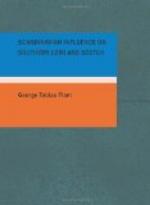CLUBBIT shows W. Scand. assimilation of mb < bb.
DRUCKEN exhibits W. Scand. assimilation of nk > kk. Cp. O.Dan.
dronkne, drone, but N.Dan. drukken.
HARN corresponds better to O.N. hjarni than to umlauted Dan.
hjerne, O.Sw. hiaerne.
ILL, WILL. Both show assimilation of ld to ll. Cp. O.N.
illr, villr, but Dan. ilde, vild.
RUND, ROOND, is rather the O.N. rond than Dan. rand.
SER, SEIR corresponds better to O.N., O. Ic. ser than to O.Dan.
saer. This change of e to ae in Dan. was, however, late,
i.e., in the last part of the 10th Century. See Noreen
P.G.(2)I, 526.
SLAK, O.N. slakki. Shows W. Scand. assimilation of nk > kk.
STAPP, O.N. stappa. Has W. Scand. assimilation of mp > pp.
Cp. cappit.
STERT is O.N. sterta. Cp. Dan. styrte.
WANDRETH is nearer to O.N. vandraeethi than to O. Dan. *_vandraþ_
(Brate), from which N.Dan. vanraad.
Monophthongization of ou to o, ai to i (e), oey to oe took place in O. Dan. about 900. The Scand. loanwords in Eng., where the monophthong might be expected to appear, nearly always have the diphthong, however, which as we know was kept in W. Scand. Have such words been borrowed from W. Scand. then, or were they borrowed from Dan. before the period of monophthongation? Danish settlements began in the latter half of the 9th Century, but Dan. (and Norse) and Eng. did not merge immediately. Scand. continued to be spoken throughout the next century down to the beginning of the 11th Century (Noreen). Brate says the majority of loanwords probably came in in the beginning of the 10th Century. Wall points out that the Mercian and the Northumbrian Gospels of the 1st part of the 10th Century show extremely small traces of Scand. influence. It would seem, then, that the greater number of loanwords came in after monophthongation had taken place in Dan. The following dates for the appearance of loanwords in the Anglo-Saxon Chronicle may be of interest. These are all taken from Egge’s article, “Norse Words in the A-S. Chronicle.”
Hold first appears in 905, then again in 911 and 921; law in the present sense is first used in 959; in 1002 is first found the word grith, peace, which at once became common; laetan, to think, is first found in 1005. In 1008 appears sagth; in 1011 hustinge; 1014 utlagian; 1048 the noun utlah; 1016 feologan; 1036, 1046, 1047, lithmen, sailors; lith, fleet, in 1012, 1066, 1068, 1069, 1071; in 1055 sciplith; in 1036, 1041, 1054, 1045, and 1071 huscarl; hamule, hamle 1039; ha 1040; hasata, rower, (O.N. ha-saeti) in 1052; in 1048 bunda and husbunda; 1049 nithing; in the same year also the phrase scylode of male, paid off (O.N. skilja af mali); 1052, 1066 butscarl, boatsman, hytte in 1066, wyrre 1066. In 1072 for the first time appears tacan; in 1076 hofding and brydlop, etc.




